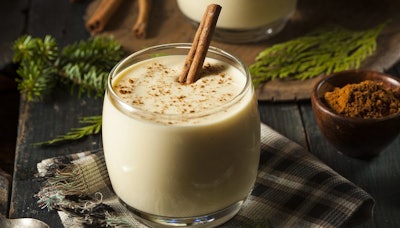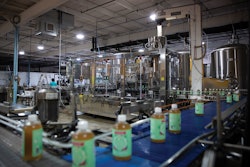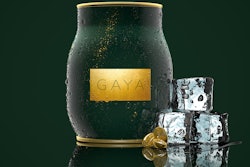
In December, I worked with Package InSight to explore a holiday grocery staple: eggnog. We know successful packaging attracts and retains shopper attention, but we were also looking to understand if packaging lives up to its promise—a question we had not previously explored. To do this, we recruited real shoppers, split 50/50 between those who traditionally purchase eggnog and those who do not, and observed how they approached and made decisions on a competitive eggnog planogram.
To cap off the consumer deep dive, we set up a taste test between some of the most popular brands, with and without their packaging, to see how consumer opinions are swayed by product branding and marketing. Most of us have heard about the Coke vs. Pepsi taste tests, but expanding this into an entire category and combining the taste test with biometric and quantitative data is something new.
To be thorough, we collected food sensory data graded on a hedonic scale, qualitative questionnaires, shopper purchases, and quantitative shopper eye tracking. This yielded an empirically-driven, broad understanding of the eggnog category, packaging design, resulting consumer behavior, and user experience. We created an expansive planogram by auditing five national grocers and gathering 24 varied eggnog products, including non-dairy, organic, flavored, store brands, and mid-range, mass-market brands. This was our best approach to creating a comprehensive understanding of the eggnog consumer while providing objective feedback to brands and category stakeholders on package design and retail grocery market positioning.
The final product is a robust report and video presentation, but here are three powerful takeaways unveiled within the report:
Eye-tracking findings:
Shoppers spent an average of 1.17 seconds looking at eggnog packaged goods (per SKU), and the length of attention positively correlated with purchases. Three of the four brands with the longest attention were the top-selling brands.
We also looked at individual label elements, including brand name, product name, visual illustrations, and callouts, and discovered that shopper attention is generally most focused on brand names and product illustrations. Calorie counts and “Ultra-Pasteurized” callouts were most often overlooked.
Qualitative surveys:
As mentioned before, we split our population between those who consider themselves eggnog fans and those who prefer not to drink eggnog. Of our aficionado group, most “purchased” the brand they would normally buy, but over a third indicated they didn’t have a preferred brand. That’s a pretty large cut of the market to be unaffiliated. For those who don’t purchase eggnog, 44% reported just not liking the taste, but 22% admitted they had never tried it. If you were creating a new brand of a classic product, how would you attract enthusiasts and entice someone else to try it for the first time?
Taste test:
For this last activity, we invited our eggnog drinkers to participate in a taste test where they encountered three different eggnog packages with numbered samples in front of them—our “branded” samples. Next to those were three more numbered samples with no packaging—our “blind” samples. We chose three varied brands: one organic “high-end” brand, one popular “mass-market” brand found in all the stores we audited, and one less-expensive “no-frills” brand. Participants were asked to taste each sample and rate several of their characteristics on a 9-point hedonic scale (from extreme dislike to extreme like). What the participants didn’t know was that the branded samples and blind samples were the same three products.
The findings here were fascinating, as seen in the accompanying chart. Our organic sample was rated pretty highly when participants were aware of the brand, but the same blind sample was rated the lowest of all the products. The no-frills brand was a little lower in the blind test, but not a huge difference. And the mass-market brand was the most consistent, with the difference between the overall weighted averages being within 5/100ths of a point. (We seemed to have made a good call including this brand; it was also the most often purchased by our participants during the shopping/eye-tracking portion of the study.) This style of testing definitely demonstrated our hypothesis that effective branding and packaging can elevate a product in the mind of the consumer.
Research like this provides value for every food company and supplier of packaging. It can give them a comprehensive understanding of their customer, their packaging’s effectiveness, and their packaging’s impact on the product experience—all things that help improve sales and the bottom line for our consumer-driven industries.
Learn more about what the research team did here.
Dr. R. Andrew Hurley is the founder of Package Insight and The Packaging School, and an Associate Professor at Clemson University.


























